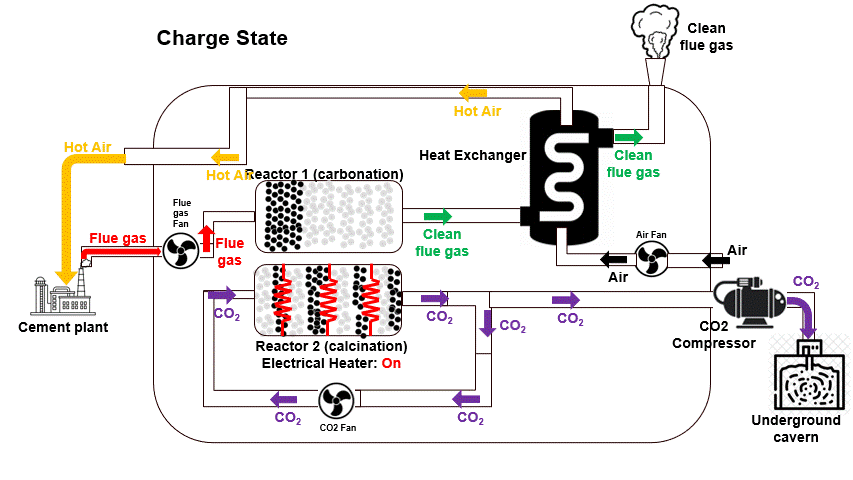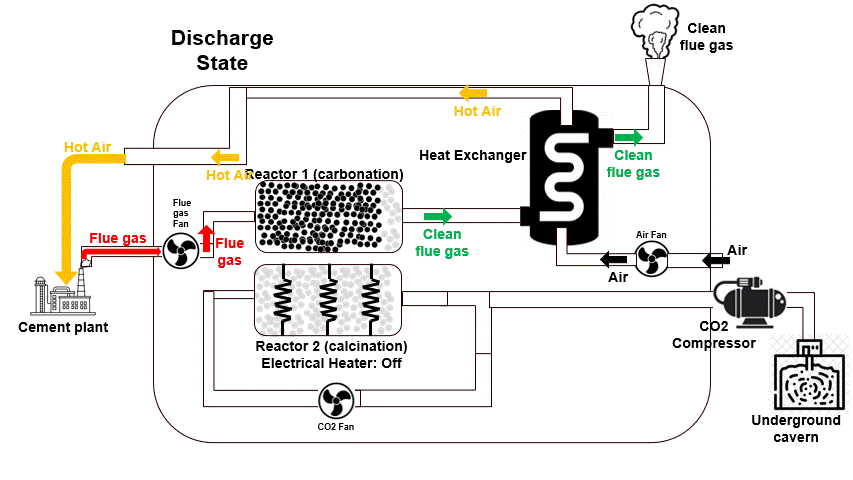
Smart Carbon Capture Battery
Remedium is developing a ground-breaking carbon capture solution that by using a single asset it provides a secondary function of grid-scale electricity or high temperature heat storage. This adds revenue to carbon capture significantly reduces the associated cost.
Problem we are solving
The primary challenge in scaling up carbon capture technology is not its technical feasibility, but its cost. The cost is particularly high in industries such as cement ($104 to $194 per tonne) and steel ($71 to $119 per tonne). Consequently, these sectors are often reluctant to adopt carbon capture solutions despite their significant CO₂ emissions.
To drive meaningful adoption, any breakthrough in carbon capture must substantially reduce these costs.
Our techno-economic analysis of the calcium looping process using natural sorbent shows that over 60% of CO₂ capture costs are attributed to energy and material expenses. To address this, we have developed two key innovations:
-
Limeloop — our proprietary carbon capture material that captures 36 times more CO₂ over its lifetime than natural limestone.
-
Smart Carbon Capture Battery (SCCB) — our novel carbon capture process that integrates carbon capture with a heat battery. By leveraging fluctuations in electricity prices, SCCB effectively reduces the energy costs associated with CO₂ capture.
How carbon capture battery works
Reducing the energy costs associated with carbon capture is particularly challenging due to the fundamental constraints of the Second Law of Thermodynamics — separating CO₂ inherently requires energy. While this energy demand can be minimized, it cannot be eliminated. However, the cost of this energy can be significantly reduced — or even offset — with the right approach.
Remedium’s SCCB addresses this challenge through its innovative dual-mode operation:

-
Mode 1: Carbon Capture & Energy Generation – Captures over 90% of CO₂ from industrial flue gases while simultaneously delivering 24/7 high-temperature heat for industrial processes.
-
Mode 2: CO₂ Storage & Sorbent Regeneration – Utilizes low-cost, intermittent electricity (e.g., renewables or off-peak grid power) to regenerate the sorbent and release pure CO₂ for storage or utilization.
By storing and strategically using inexpensive electricity, SCCB dramatically reduces the energy costs associated with carbon capture. This innovation not only lowers capture costs to just $10–$15 per tonne but also enables continuous-operation industries like cement and steel to benefit from affordable renewable energy — improving economic feasibility while creating additional revenue streams.

Mode 1 and Mode 2 are operational

Only Mode 1 is operational
Why Smart Carbon Capture Battery can be a breakthrough climate change mitigation solution
Key Advantages of Smart Carbon Capture Battery
-
Lower Carbon Capture Costs: SCCB’s innovative design, featuring Limeloop and integrated heat storage, reduces carbon capture costs by approximately 80%—achieving an exceptionally low capture cost of just $13/tCO₂, far below conventional solutions.
-
High Efficiency and Broad Application: SCCB captures 90% of CO₂ emissions and operates effectively with CO₂ concentrations ranging from 5% to 30%.
-
Enhanced Temperature Flexibility: Unlike amine-based systems that require flue gas cooling, SCCB can capture CO₂ directly from flue gas at temperatures between 25°C and 300°C.
-
No Flue Gas Dehumidification Required: Unlike many conventional methods, SCCB thrives in humid environments, where moisture can even enhance calcium-based capture processes.
-
Electrification for Greener Operation: Unlike traditional CCUS systems that rely on fossil fuels, SCCB is fully electric, reducing carbon emissions and aligning with the global transition to low-carbon energy systems.
-
Simplified Design with Fewer Components: Electrification eliminates the need for an air separation unit (commonly required in CaL plants for oxyfuel combustion) and a CO₂ purification unit—two of the most expensive components in conventional CaL systems.
-
Integrated Heat Storage: SCCB’s ability to store high-temperature heat allows industrial plants to integrate seamlessly with intermittent renewable energy sources. This functionality eliminates the need for separate heat storage systems, ensuring uninterrupted operations even during energy supply fluctuations.
-
Modular Design for Easy Deployment: SCCB’s simplified, modular design enhances flexibility, making it easier to implement, expand, and scale.
-
SOₓ Capture: SCCB can potentially be used to also capture SOₓ, removing the need for additional scrubbing units.
-
Minimal Waste Generation: The closed-loop design minimizes waste. Spent sorbents can be repurposed in cement production, reducing waste management costs.
-
Retrofitting Capability: SCCB can integrate seamlessly with existing infrastructure, minimizing the need for costly new installations.
-
Scalability with Abundant Materials: SCCB leverages abundantly available limestone, ensuring scalability without concerns about material shortages or supply chain risks.
